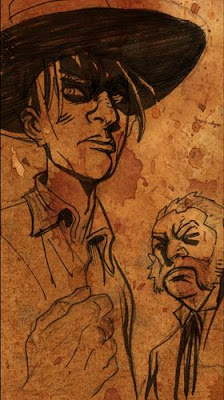On the first night of the full moon, Matthew Macgregor sits in his rocking chair, with a pistol in his lap and a bottle of moonshine.I wrote that sentence over three years ago now. It was the first line in what would be the very first
HIGH MOON plot synopsis. Since that time, I've accrued more research on Texas, The Wild West, and Werewolves than I ever thought possible.
And,
HIGH MOON is better off for it.
To tell you you truth, I was never a huge fan of westerns. That is not to say that there aren't some fantastic stories of the old west, but for the most part, I found many of the tales of the old west a little too simple for my tastes.
The man who changed that perception for me was a writer by the name of John Meston. John doesn't get a lot of credit these days, but he was the principal writer behind the radio series
GUNSMOKE.
Simply put, GUNSMOKE was the story of the violence that moved west with young America…and the story of a man who moved with it,” Marshall Matt Dillon. Often referred to as the medium's first "Adult Western," this exceptional program set the standard for all of the shows that were to follow.
Meston thought that few Westerns gave any inkling of how brutal the Old West, and he was dedicated to destroying the cherished archetypal Western hero. Raised in the remnants of the old west, Meston was notable for the use of parsed dialogue and lack of 'purple prose.' Unless it was for effect, Meston never wrote speeches, preferring the 'less is more' school of thought.
"I don't phony stuff. And, I knew a something about the west ... the way people are and the way they talk and the way they behave. And, I never liked heroes much," Meston said in the GUNSMOKE biography.
Writing down every tired cowboy troupe they could think of, Meston, along with producer/director Norman MacDonnell, decided to break every single one.
Which brings us back to where we are now. HIGH MOON started as a simple werewolf western, a straight-up old-style-shoot-em-up, but as it has developed over the years, it has become something more. As I get ready to type out the next several scripts, I am fascinated with how HIGH MOON has developed. We've set up the pieces, and over the course of the next 52 screens you'll see them all move in some very interesting and unique ways.
Writing HIGH MOON is something that speaks to my fondness for pulps, mythology, history, and old-time radio. It is a story that you won't need a PHD in Comics to read, understand, and enjoy. I owe quite a bit of its success to John Meston and Gunsmoke.












